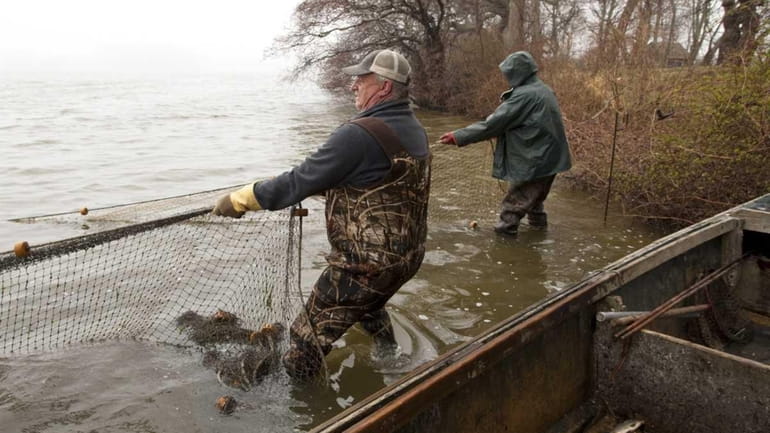Southampton Town targets invasive carp

Baymen Dan Schellinger, left, and his dad, George, on Mill Pond in Watermill remove unwanted carp on the 85-acre pond. (Apr. 11, 2011) Credit: Randee Daddona
Almost four years after a nitrogen-based algae bloom set off a massive fish kill in Mill Pond in Water Mill, the Southampton board of trustees is taking steps to stop an abundance of invasive carp from causing the same problem.
The board hired two local baymen, father-and-son Dan and George Schellinger, to net the species during the current fish spawning season. The fishermen will dispose of the smaller fish in a trash bin, but the town plans to sell some of the adult catch on the open market in Manhattan.
The trustees, a governing body that protects the town's environmental concerns, say the bronze carp, a nonnative species that has been proliferating over the years, have taken over aquatic life in Mill Pond.
"The trustees have been trying to manage the pond ever since" the 2008 kill, said Jim Walker, a principal planner with Interscience Research Associates in Southampton, which the town contracts with on marine matters.
The carp, which run up to 6 feet long, can weigh as much as 100 pounds and vary in color, feed by grazing on the bottom of a body of water, which stirs up sediment containing phosphorous and nitrogen fertilizers and forms algae blooms in hot weather, said Southampton Town Trustee Frederick Havemeyer. When the weather turns cold, the algae organisms die, taking oxygen and suffocating less hardy fish. In 2008, an algae bloom killed off thousands of fish in the 85-acre Mill Pond, including perch and large-mouthed bass, Havemeyer said.
Nitrogen runoff from backyards abutting bodies of water is a big problem, he said, adding that the town has had promotional campaigns to plant buffers between the two.
"There is a definite balance in nature, and whenever that balance is disrupted, usually by man, there are big problems," Havemeyer said.
The U.S. Fish and Wildlife Service lists carp as an aquatic invasive species. Bodies of water in Minnesota and the Great Lakes have also battled carp and algae blooms.
It's not clear how the nonnative fish got into the pond. A rumor, said Havemeyer, is that the state placed them there in the 1950s for recreational fishing, and others say that homeowners who had carp in their residential ponds tossed them there when they got too big.
The catch began last month, and with a brief respite because of cold weather, the Schellingers have netted more than 700 pounds of the carp. They estimated some fish have weighed at least 25 pounds.
Protecting water quality
The Southampton trustees urge the town's residents who live along the town's 99 lakes and ponds to help keep the waters healthy by preventing fertilizer runoff:
-- Create and maintain natural buffers of flowers and other safe vegetation along the water's edge. Call the town's conservation board at 631-287-5710 for a list of native plants to use as buffers.
-- Use slow-release fertilizer and balance the pH of the lawn with lime for more efficient absorption.
-- Pull weeds rather than kill them with herbicides and pesticides.
-- Upgrade or replace faulty septic systems. Don't dispose of hazardous waste in sinks or toilets.
-- Pick up after your pets.
-- Report clogged catch basins to the town's Highway Department.
